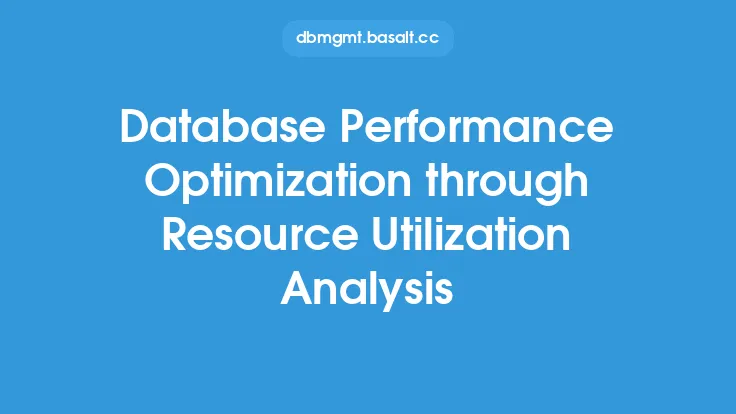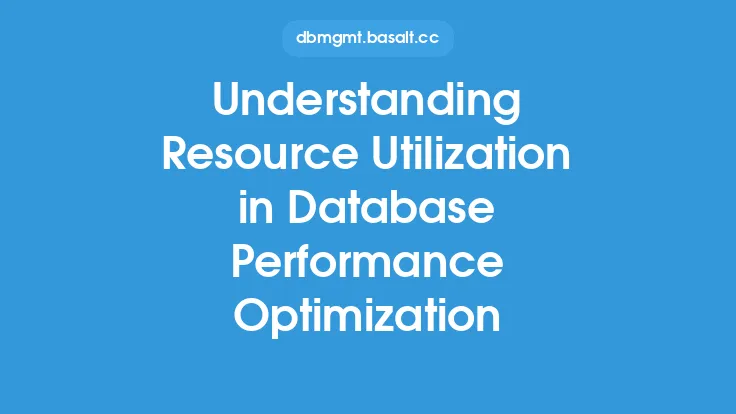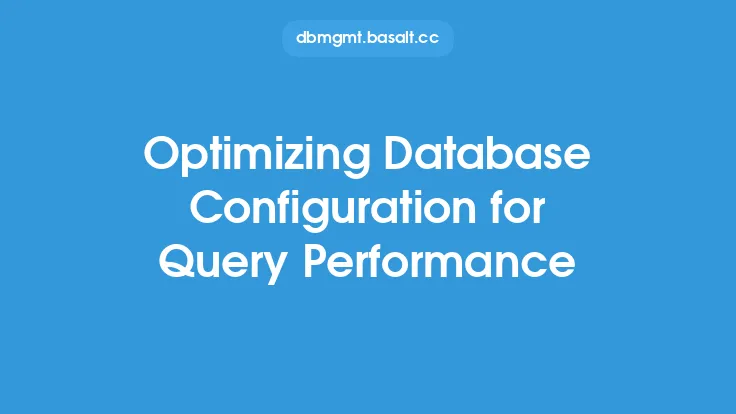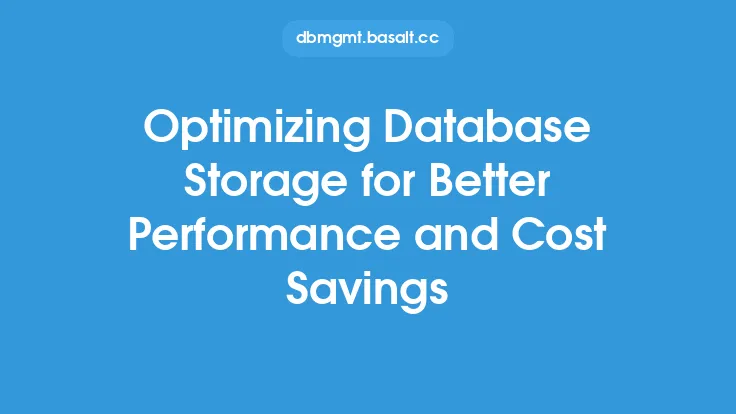Optimizing database resource utilization is crucial for achieving better performance in database systems. Database resources such as CPU, memory, storage, and network bandwidth are essential for processing database queries, storing data, and managing database operations. When these resources are not utilized efficiently, it can lead to performance degradation, increased latency, and decreased throughput. In this article, we will discuss the importance of optimizing database resource utilization and provide techniques for achieving better performance.
Introduction to Database Resource Utilization
Database resource utilization refers to the efficient use of database resources to process database queries, store data, and manage database operations. Database resources include CPU, memory, storage, and network bandwidth. Each of these resources plays a critical role in database performance, and optimizing their utilization is essential for achieving better performance. For example, CPU is responsible for executing database queries, memory is used for caching data, storage is used for storing data, and network bandwidth is used for transferring data between nodes.
Understanding Database Resource Bottlenecks
Database resource bottlenecks occur when a database resource is fully utilized, causing a decrease in database performance. Identifying and resolving resource bottlenecks is essential for optimizing database resource utilization. There are several types of resource bottlenecks, including CPU bottlenecks, memory bottlenecks, storage bottlenecks, and network bottlenecks. CPU bottlenecks occur when the CPU is fully utilized, causing a decrease in query performance. Memory bottlenecks occur when the memory is fully utilized, causing a decrease in query performance and increased disk I/O. Storage bottlenecks occur when the storage is fully utilized, causing a decrease in query performance and increased disk I/O. Network bottlenecks occur when the network bandwidth is fully utilized, causing a decrease in query performance and increased latency.
Techniques for Optimizing Database Resource Utilization
There are several techniques for optimizing database resource utilization, including query optimization, indexing, caching, partitioning, and parallel processing. Query optimization involves optimizing database queries to reduce the amount of resources required to execute them. Indexing involves creating indexes on columns used in WHERE and JOIN clauses to reduce the amount of data that needs to be scanned. Caching involves storing frequently accessed data in memory to reduce the amount of disk I/O. Partitioning involves dividing large tables into smaller tables to reduce the amount of data that needs to be scanned. Parallel processing involves executing multiple queries concurrently to reduce the amount of time required to execute them.
Query Optimization Techniques
Query optimization is essential for optimizing database resource utilization. There are several query optimization techniques, including selecting the optimal query execution plan, avoiding full table scans, using indexes, and avoiding correlated subqueries. Selecting the optimal query execution plan involves choosing the query execution plan that requires the least amount of resources. Avoiding full table scans involves using indexes or other optimization techniques to reduce the amount of data that needs to be scanned. Using indexes involves creating indexes on columns used in WHERE and JOIN clauses to reduce the amount of data that needs to be scanned. Avoiding correlated subqueries involves using joins or other optimization techniques to reduce the amount of resources required to execute subqueries.
Indexing and Caching Techniques
Indexing and caching are essential for optimizing database resource utilization. Indexing involves creating indexes on columns used in WHERE and JOIN clauses to reduce the amount of data that needs to be scanned. Caching involves storing frequently accessed data in memory to reduce the amount of disk I/O. There are several indexing techniques, including B-tree indexing, hash indexing, and bitmap indexing. B-tree indexing involves creating a balanced tree index on a column to reduce the amount of data that needs to be scanned. Hash indexing involves creating a hash index on a column to reduce the amount of data that needs to be scanned. Bitmap indexing involves creating a bitmap index on a column to reduce the amount of data that needs to be scanned.
Partitioning and Parallel Processing Techniques
Partitioning and parallel processing are essential for optimizing database resource utilization. Partitioning involves dividing large tables into smaller tables to reduce the amount of data that needs to be scanned. Parallel processing involves executing multiple queries concurrently to reduce the amount of time required to execute them. There are several partitioning techniques, including range partitioning, list partitioning, and hash partitioning. Range partitioning involves dividing a table into partitions based on a range of values. List partitioning involves dividing a table into partitions based on a list of values. Hash partitioning involves dividing a table into partitions based on a hash function.
Monitoring and Analyzing Database Resource Utilization
Monitoring and analyzing database resource utilization is essential for optimizing database performance. There are several tools and techniques for monitoring and analyzing database resource utilization, including database management system (DBMS) tools, operating system tools, and third-party tools. DBMS tools involve using tools provided by the DBMS to monitor and analyze database resource utilization. Operating system tools involve using tools provided by the operating system to monitor and analyze database resource utilization. Third-party tools involve using tools provided by third-party vendors to monitor and analyze database resource utilization.
Best Practices for Optimizing Database Resource Utilization
There are several best practices for optimizing database resource utilization, including monitoring and analyzing database resource utilization, optimizing database queries, using indexing and caching, partitioning large tables, and using parallel processing. Monitoring and analyzing database resource utilization involves using tools and techniques to monitor and analyze database resource utilization. Optimizing database queries involves using query optimization techniques to reduce the amount of resources required to execute queries. Using indexing and caching involves using indexing and caching techniques to reduce the amount of data that needs to be scanned. Partitioning large tables involves dividing large tables into smaller tables to reduce the amount of data that needs to be scanned. Using parallel processing involves executing multiple queries concurrently to reduce the amount of time required to execute them.
Conclusion
Optimizing database resource utilization is crucial for achieving better performance in database systems. Database resources such as CPU, memory, storage, and network bandwidth are essential for processing database queries, storing data, and managing database operations. By using techniques such as query optimization, indexing, caching, partitioning, and parallel processing, database administrators can optimize database resource utilization and achieve better performance. Additionally, monitoring and analyzing database resource utilization is essential for identifying and resolving resource bottlenecks and optimizing database performance. By following best practices for optimizing database resource utilization, database administrators can ensure that their database systems are running efficiently and effectively.





